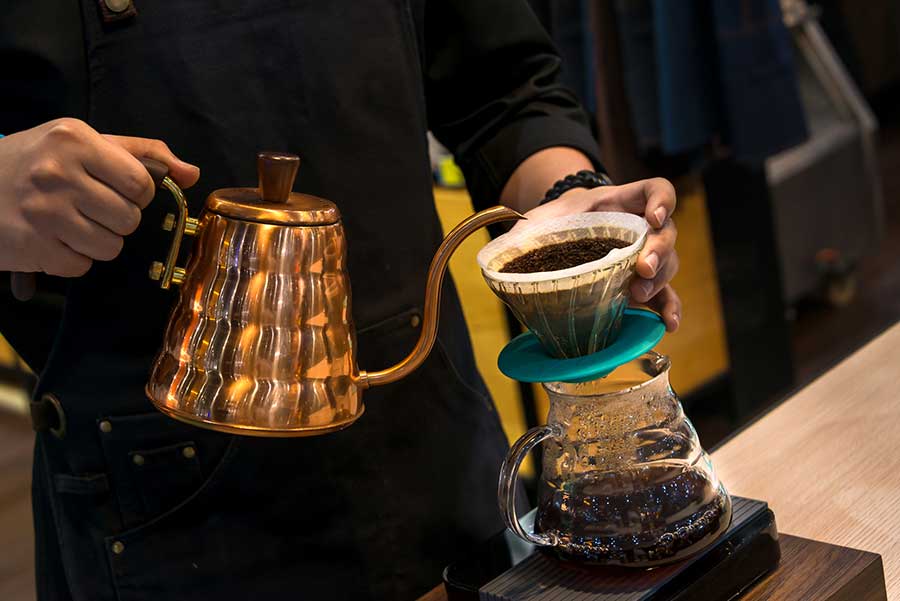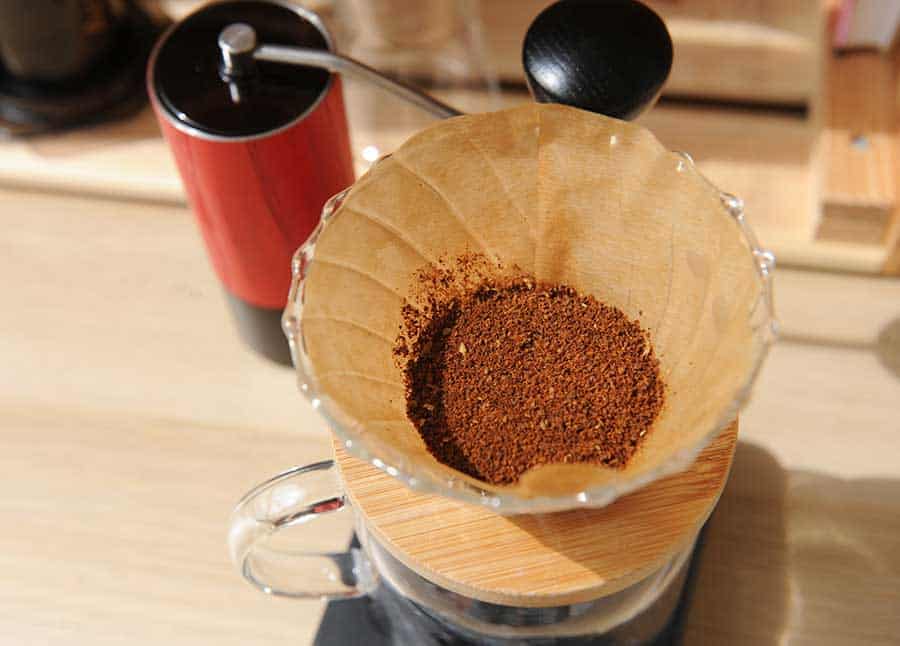What Grind to Use for Pour Over Brewing

Contrary to what you may have seen or imagined, there’s more to making pour-over coffee than just, well, pouring over hot water onto coffee grounds. It needs quite a bit of finesse to get a satisfying brew. Grinding the coffee, for one, is quite tricky, especially figuring out what the grind size is for pour over.
Maybe you are toying with the idea of walking into a coffee shop and asking a vendor for pre-ground coffee for your pour over coffee maker. It sounds like a nice hack, but trust me, the brew will only be a shadow of the full potential of those coffee beans for pour over coffee.
Grinding coffee beans to the right size isn’t a cakewalk, but it’s nothing you can’t handle. Before I start discussing the correct grind size for pour over coffee brewing, it is important that you also learn what this brewing method is all about and why grind size matters.
What’s Pour Over Coffee?
Of all the coffee brewing methods, pour over coffee is probably the simplest. It doesn’t involve the use of a coffee machine or special coffee maker. Basically, it’s just a funnel and a filter.
Of course, there are other tools and techniques that would up the deliciousness of your coffee and extract the best flavor from it, like a good grinder and a gooseneck kettle.
Some great pour over coffee makers you will hardly go wrong with include:
- Chemex Pour-Over Glass Coffee Maker
- Hario V60 Ceramic Coffee Dripper Pour Over Cone
- Kalita Wave 185 Dripper
The brewing process is simple and straightforward. First, heat the water to between 195 and 205 degrees Fahrenheit. Gradually add the heated water to coffee grounds in a filter. Do the pour in stages so that the grounds are saturated evenly, given the time to bloom, and given the time to bring out their full flavor.
Water will then filter through the grounds and drip into the cup. Initial drops will be too acidic and potent on their own, but as extraction goes on, delicate and subtle flavors will be brought out to balance out the taste.
Now, you will be lucky to get this right on your first try, but as you experiment further you will get the hang of it. One of the factors that plays a big role in how your pour over brew turns out is the grind size.
Why Pour Over Coffee Grind Size Matters
You may have all the best gear in the world for making coffee, but there’s one more thing you have to get right for your brew to turn out great: grind size and consistency. Just to be clear, this doesn’t apply to pour overs alone but to all coffee makers and machines.

It would be great for you as a coffee connoisseur to know the best and recommended grind sizes for different coffee makers.
The rule of thumb that you should never forget when grinding is that the finer the grind is, the less contact it will need with water (and vice versa) to extract the flavors. Coarser grinds take longer to discharge their flavors because the particles have less surface area than finer grinds; therefore, they need more time for optimal extraction.
Let’s find out why this really matters:
Flavor
Part of brewing involves water moving through your coffee beans, extracting caffeine alongside distinctive and subtle flavors. It’s one of the most delicate parts of the process because under-extraction or over-extraction will get you weak, bland coffee or a bitter, overly strong brew.
You have to get the process right, and it all begins with ensuring you are using the recommended grind size for your coffee maker. Water temperature and filters are the other things you will have to consider.
Wrong sizes may also take longer or fail to go through the filters. You do not want such a brewing experience with your pour over on a bright and promising morning. It’s easy to avoid this though. Just make sure you know as much as possible about pour over coffee grind size.
What Grind Size to Use for Pour Over Coffee
Let’s talk about brewing time first. Making great pour over coffee takes 3 to 5 minutes on average. In other words, that’s the period you have to keep the heated water in contact with the coffee grounds. Even a minute more or less is enough to ruin your brew.
To extract the right flavor from coffee grounds in this period of time, your grind size has to be medium-fine. This is the best grind for pour over brewing. You may have noticed from the table above that this particular size falls between the fine espresso grind and the medium grind for drip coffee.
Pour over brewing, as you would discover, could fail. But if you learn from the failures and make the proper adjustments, you’ll definitely do better in your next brew. Sometimes your pour over coffee will taste very sour or brew in less than 3 minutes.
Do not panic, though. Chances are good that you used a coarser grind. Make it finer next time to slow the flow of water and optimize extraction.
Other times, your brew may taste too bitter, with a lingering unpleasant aftertaste. Extra fine grounds are more likely to cause that, so coarsen them a little bit to prevent over-extraction.
Grind size aside, extraction will also depend on roast level, batch size, and the pace at which you pour the water through the grounds.
How to Get Consistent Grind Size for Your Pour Over
It may be tempting to opt for pre-ground coffee, but that would deny you the chance to experience sweet delicious pour over coffee. Choose freshly roasted whole coffee beans instead, and more importantly, use a proper grinder.

You may have seen the blade vs burr grinder debate and are probably wondering which option to choose between these two. Let’s talk about each briefly.
Blade Grinders
Blade grinders are more affordable and convenient, but their biggest downside is that they provide an uneven grind size. Some grounds will be fine, while others will be very coarse. An inconsistent grind, unfortunately, causes uneven extraction, which in turn unbalances the flavors in your brew.
Burr Grinders
Burr grinders, on the other hand, cost more but produce uniform and consistent coffee grounds and also allow you to adjust the grind size. One of the best options in the market today is the Fellow Ode grinder.
Blade grinders, therefore, won’t create the desired consistent, medium-fine grind coffee needed to make a better-tasting cup of joe. A burr grinder will do that with ease, ensuring you have the best grind for pour over brewing.
In addition to burr grinders, you are also going to need a gram scale and a slow-pouring kettle so as to get the best out of your pour over brewer. Get a thermometer as well if your kettle lacks an in-built temperature display.
Frequently Asked Questions
Are all pour overs the same?
Yes. All pour overs work the same way, no matter the design. Hot water will go through the coffee filter, extracting flavors and caffeine and dripping the resulting brew into a mug.
While shopping for one, you will come across different designs and brand names. Materials range from plastic and stainless steel to glass and ceramic. Some will have more cup capacity than others.
Chemex models, for instance, come with custom filters and a cup capacity of up to 10 cups, but the majority of pour over coffee makers have a lower cup capacity, ranging from 2 to 4 cups.
How do you make the perfect pour over?
To begin with, choose the right grind size. In this article, we have talked a lot about why grind size matters.
Make sure the water you are using for brewing is clean as well. Filtered water remains the best because it is pure and has a lower concentration of minerals. Hard or undistilled water will swallow up the coffee flavors.
Coffee-to-water ratio matters as well. 1:17 is the recommended average (more about this later).
Next, perfect your pour. Start by adding an amount twice the size of the coffee. Stir gently for about 30 seconds, then add more water slowly and in steady spirals or controlled circles to make the extraction even. An electric or stovetop gooseneck kettle is perfect for this.
The rest of the work will involve timing and adjustment. If you fail to get the desired brew, keep adjusting your grind size and varying the brewing time until you find the sweet spot. It may be challenging at first but you will get the hang of it with time.
How do you pick beans for pour over?
Pour over coffee makers are known to bring out the best flavors from all kinds of roasts. Lighter roasts produce more complex floral and fruity notes compared to darker roasts. Medium roasts strike the perfect balance between flavor and aroma. What’s best for you, though, depends on your individual taste and preference.
You will also have to make a choice between single-origin and blended beans. Because they are obtained from one region, single-origin beans will only have the flavor associated with their origins. Blended beans, on the other hand, are sourced from various parts and therefore have a more balanced flavor.
Lastly, purchase freshly roasted coffee beans because this is when they are most flavorful.
What is the ratio of coffee to water in a pour over?
You will come across different suggested coffee to water ratios, but the sweet spot that baristas and coffee connoisseurs continue to vouch for is 1:17 ( 1 gram of coffee per 17 grams of water).
Start from this point and then adjust the grind size, batch size, and water temperature based on the resulting brew.
Get Grinding!
When we’re asked what the right grind size is for pour over, it would be easy to say “‘medium-fine” and then call it a day. As you have probably realized, though, there’s a lot to learn about pour over coffee grind size.
It all begins with understanding how pour over coffee makers work. Every step matters, so before you start grinding, take time to perfect your pour. Know how to use the best coffee-to-water ratio as well.
I may have mentioned it late in the process, but it is important that you shop for the best beans for pour over brewing. Use a burr grinder to crush them into medium-size particles, which is the best grind size for pour over brewing.
For beginners, be patient with the results. Keep tweaking your technique until you get a delicious brew.
Owen is a writer and editor at Caffe Streets who considers himself a coffee fanatic. He spends his time researching and testing different coffee beans and brewing methods and sharing what he learns with others.





